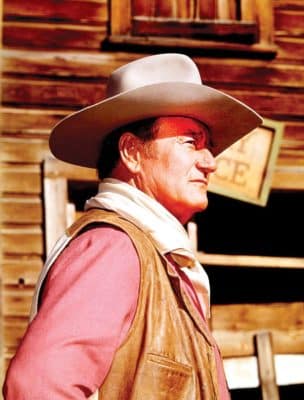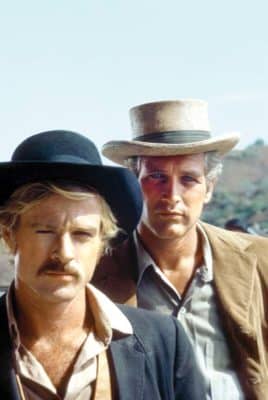
“Hollywood you shaped my life/With a Technicolor carving knife.” So sang Eliot Murphy in a 1974 song. What genre has shaped the cinema more than the Western? When the American frontier was settled in the early 20th century, an era in the country’s history had come to an end. More lands to conquer? Not in the 48 states. The frontier had been tamed, but a legend was born. The West had been won and with it, a thousand stories were ripe for the silver screen.
Even before the rise of the “talkies,” the movie industry discovered the Wild West. The first big star was Tom Mix, who starred in no less than 160 (that’s correct) cowboy films during the Roaring ’20s.
When the talkies and later, color production bloomed, so did the Western. John Ford, a native New Englander, had compiled a string of hit movies before tackling the frontier. John Wayne, his favorite star, had enjoyed only modest success. In 1939, the two teamed up for Stagecoach, the first Western to capture the imagination of the public. It was the beginning of the most successful partnership in Hollywood history. Wayne would appear in 24 of Ford’s films, many of them Westerns. Ford played a major role in shaping Wayne’s screen image. “He’ll be the biggest star ever because he is the perfect ‘everyman,’’” the director confided to friends.

It mattered. During the Depression years, movies, which usually cost only a nickel, became the prime escape route for a nation with millions unemployed. Westerns reminded audiences that the Promise of America was still alive. Which stars are remembered today? Wayne, of course, defined the cowboy for generations of movie goers. As did Gary Cooper. If one film and one scene defined the Western, it would be Cooper as Will Kane in the 1952 film, High Noon, calmly strolling down a dirt-paved Main Street, taking on a group of convicts out for vengeance. Kane was in peril, but his pacifist wife, played by the beauteous Grace Kelly saved the day.
The Western appealed greatly to Americans for a variety of reasons. The good guy vs. bad guy matchup never grows old. The Wild West was as famous for such bandits as Jesse James and Cole Younger as legendary lawmen Wyatt Earp and Bat Masterson. As important was the West and its code of conduct. A man’s word was his honor. This applied to the courtroom. Once a man gave his word to, say, stop thievery, a judge would hold it to him and set him on his way. If that same man broke his word, another story. This world, free of attorneys and legal machinations, also held a great appeal. Finally, there was the scenery. For cramped city dwellers, the West meant wide-open spaces and with it, opportunities unlimited. It captured the entire spirit of the nation. Many a young man, living in say, Warren, Ohio or New York City, would be so captivated by this genre that he would give up his current life and head out West to seek adventure and fortune.

During the 1950s, movies now had to compete with television. Executives wanted to keep a good thing going. The Western filled that loud little box that now dominated the American living room. The most famous shows are still familiar to viewers: Gunsmoke, Rawhide, The Rifleman, Bonanza, Death Valley Days and The Big Valley. In the 1950s, Davy Crockett made a comeback through Fess Parker’s portrayal of the man in a popular show. American boys donned Davy’s famous coonskin cap as the frontier remained popular in a suburbanized nation. Rawhide, a drama especially popular among New York men of a certain generation, marked the debut of Clint Eastwood. The latter is legendary as Dirty Harry, but Eastwood, in a slew of films, including High Plains Drifter, The Outlaw Josey Wales, Pale Rider and Unforgiven, became the successor to Wayne as the ultimate cowboy star.
Times—and tastes—change. By the late 1960s, the anti-hero was in vogue. The neurotic urbanite on a psychiatrist’s couch was pushing out the cowpoke. The Westerns followed suit, most significantly in Butch Cassidy and The Sundance Kid. In this 1969 movie, the outlaws were the heroes who both got the girl and the loot. Law enforcement officers were there to spoil all the fun.
At the same time, Wayne enjoyed an improbable comeback. Playing Rooster Cogburn in another 1969 blockbuster, True Grit, Wayne finally won an Oscar. That set him up for a slew of old-fashioned Westerns: The Undefeated, Chisum, Rio Lobo, Big Jake and The Cowboys. But as The Duke neared the end of the road, his world seemed to die with him.
Into the 1970s and beyond, television still trafficked in Westerns, but not with the same enthusiasm. Little House on the Prairie, a drama based on the novels of Laura Ingalls Wilder and starring Ponderosa veteran Michael Landon, was highly popular as was Dr. Quinn, Medicine Woman, starring Jane Seymour. These shows were different. Chuck Connors, blasting his way down Main Street in the opening credits of The Rifleman, was out. The gentler side of American manhood, as portrayed by Landon, was now preferable. For decades, the Western has proved irresistible to the mandarins in Tinseltown. Tastes may ebb and flow, but you can be sure that moviemakers will be coming back to the OK Corral time and time again.




















